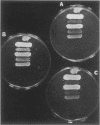Abstract
We isolated a large number of mutations in the structural gene for the plasma membrane ATPase (PMA1) of Saccharomyces cerevisiae. These mutations were selected by their resistance to the aminoglycoside antibiotic hygromycin B. Biochemical analysis of purified membrane preparations showed that the plasma membrane ATPase activity of the mutants was reduced as much as 75%. Intragenic complementation of pma1 mutants suggested that the yeast plasma membrane ATPase was a multimeric enzyme. The pma1 mutants were apparently defective in maintaining internal pH; more than half of the mutants were unable to grow either at a low pH or in the presence of a weak acid. Most pma1 mutants were also osmotic pressure sensitive. At a very low temperature (5 degrees C) many pma1 mutants were unable to grow and were arrested as unbudded cells. The three most severely affected mutants were also unable to grow in the presence of NH4+. The most extreme mutant exhibited a severe defect in progression through the cell cycle; on synthetic medium, the cells progressively accumulated nucleus-containing small buds that generally failed to complete bud enlargement and cytokinesis. Most of the pleiotropic phenotypes of pma1 mutants could be suppressed by the addition of 50 mM KCl but not NaCl to the medium.
Full text
PDF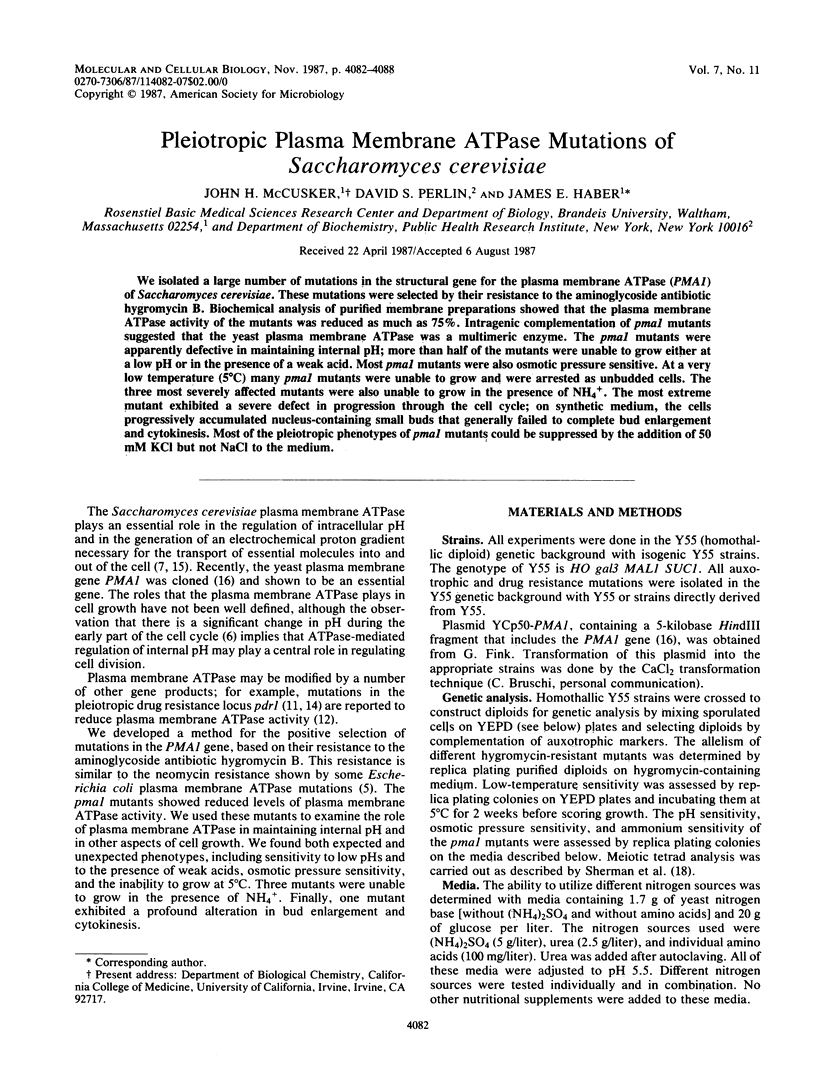
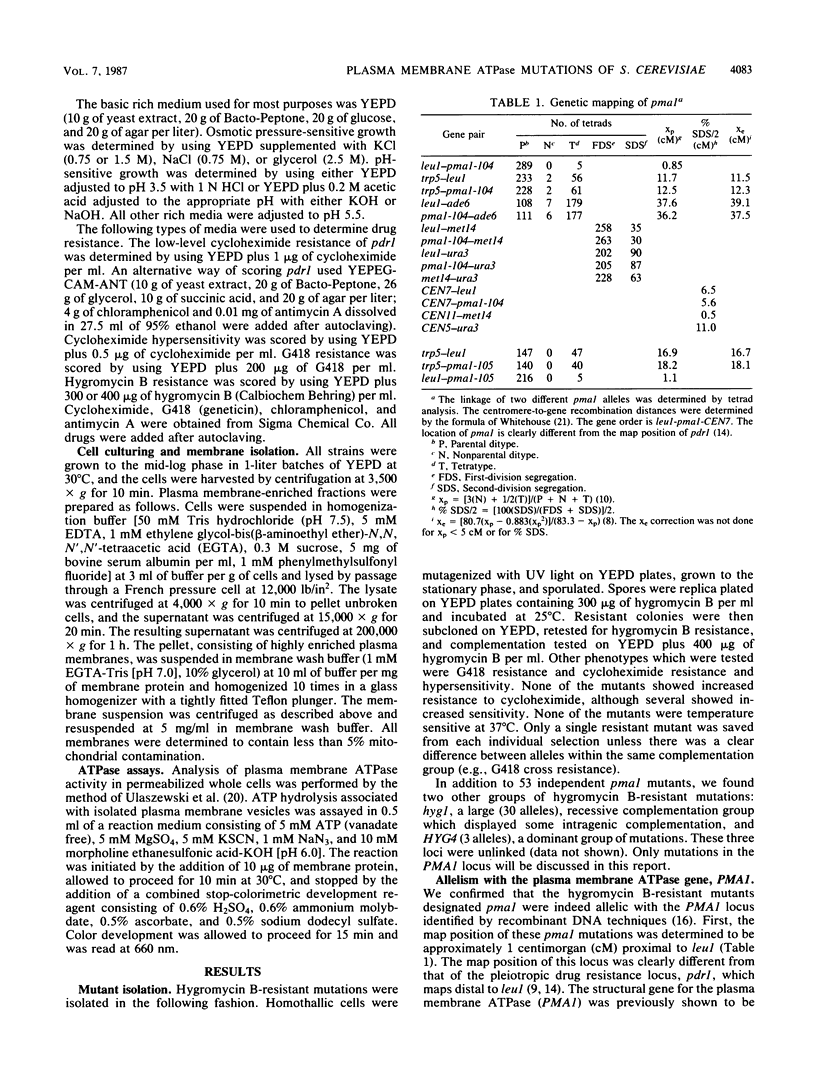
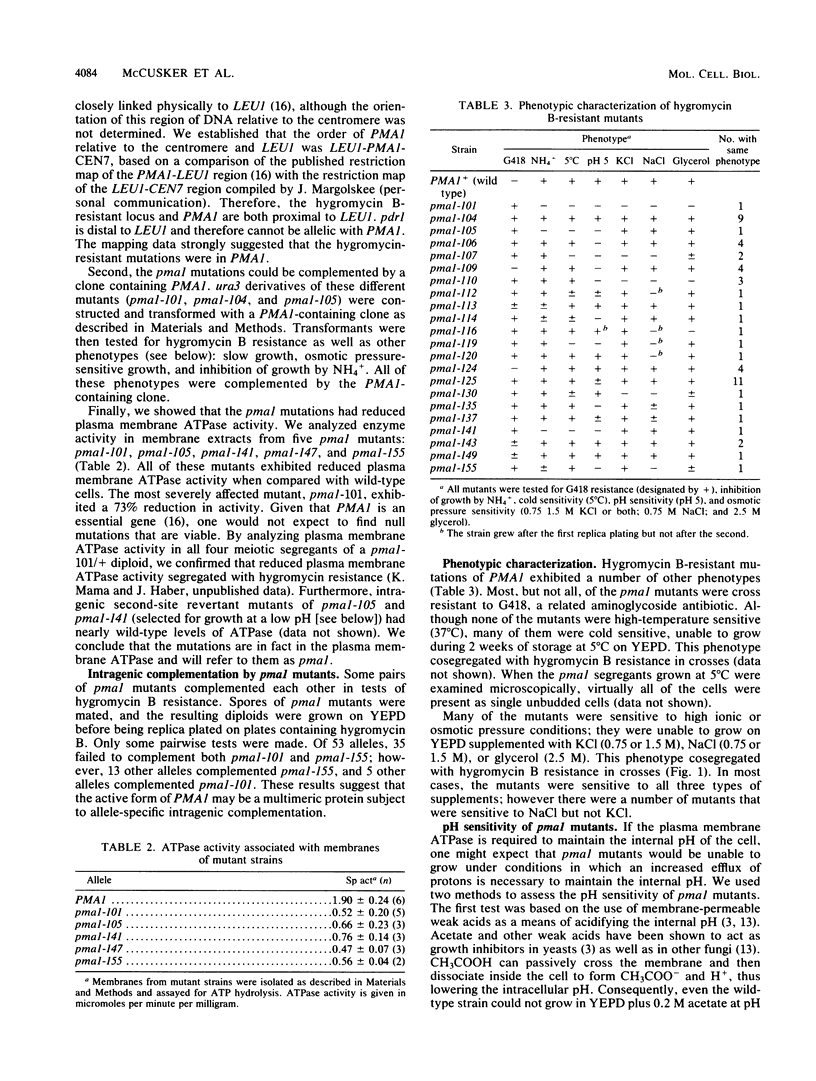
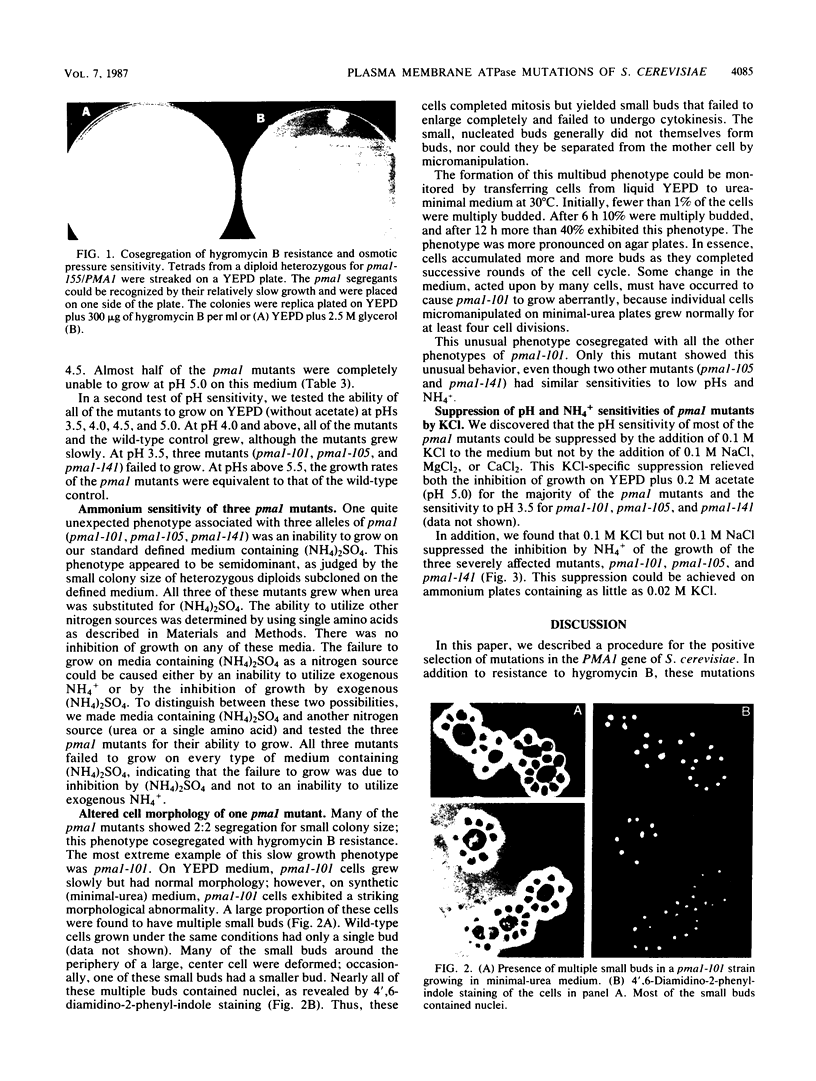
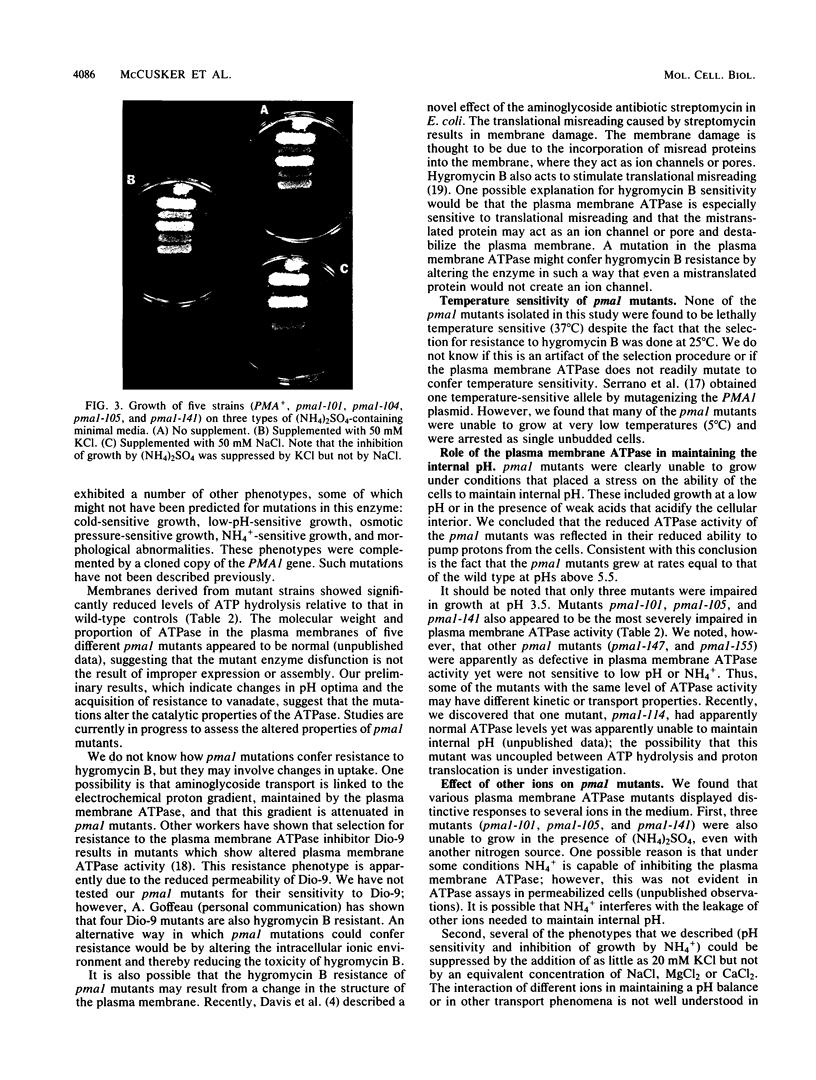
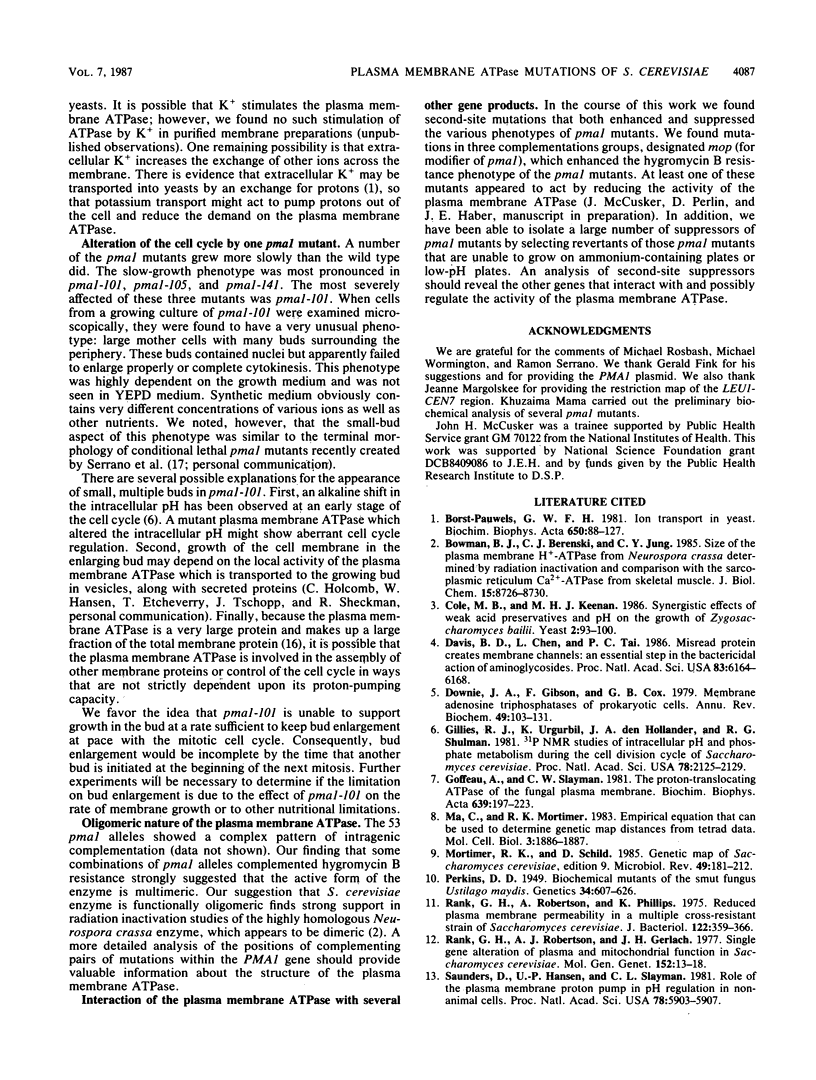
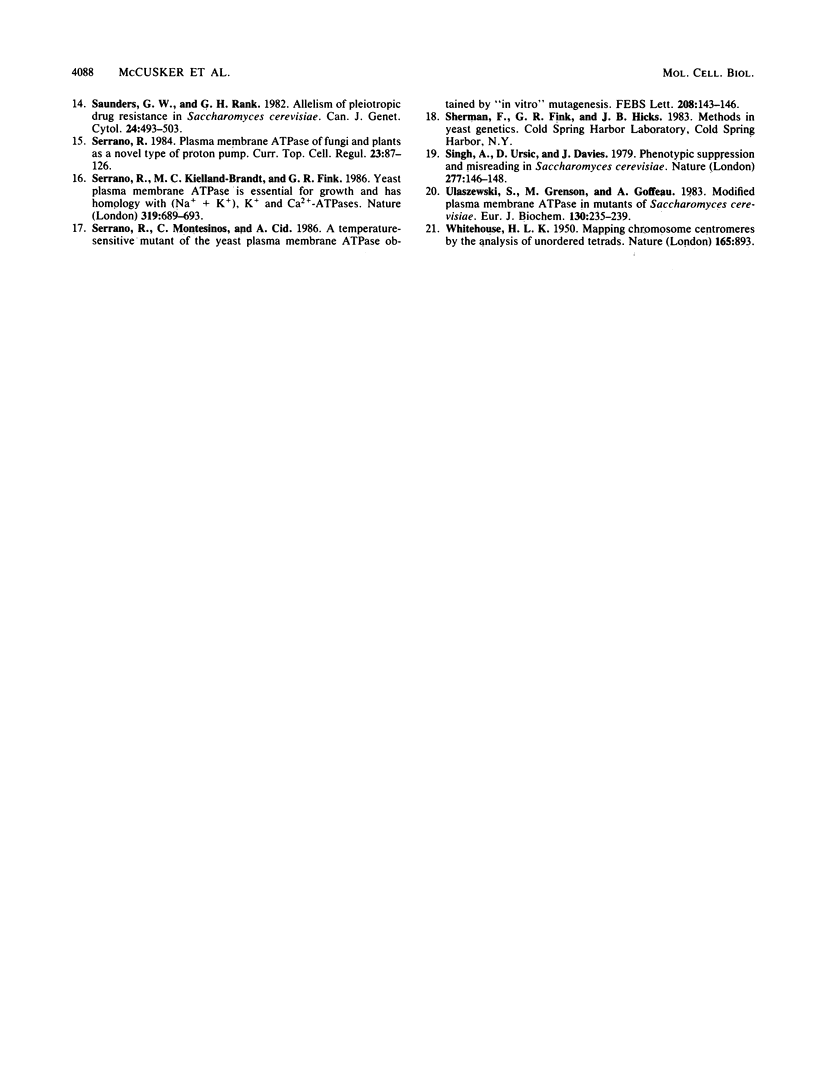
Images in this article
Selected References
These references are in PubMed. This may not be the complete list of references from this article.
- Borst-Pauwels G. W. Ion transport in yeast. Biochim Biophys Acta. 1981 Dec;650(2-3):88–127. doi: 10.1016/0304-4157(81)90002-2. [DOI] [PubMed] [Google Scholar]
- Bowman B. J., Berenski C. J., Jung C. Y. Size of the plasma membrane H+-ATPase from Neurospora crassa determined by radiation inactivation and comparison with the sarcoplasmic reticulum Ca2+-ATPase from skeletal muscle. J Biol Chem. 1985 Jul 25;260(15):8726–8730. [PubMed] [Google Scholar]
- Cole M. B., Keenan M. H. Synergistic effects of weak-acid preservatives and pH on the growth of Zygosaccharomyces bailii. Yeast. 1986 Jun;2(2):93–100. doi: 10.1002/yea.320020204. [DOI] [PubMed] [Google Scholar]
- Davis B. D., Chen L. L., Tai P. C. Misread protein creates membrane channels: an essential step in the bactericidal action of aminoglycosides. Proc Natl Acad Sci U S A. 1986 Aug;83(16):6164–6168. doi: 10.1073/pnas.83.16.6164. [DOI] [PMC free article] [PubMed] [Google Scholar]
- Downie J. A., Gibson F., Cox G. B. Membrane adenosine triphosphatases of prokaryotic cells. Annu Rev Biochem. 1979;48:103–131. doi: 10.1146/annurev.bi.48.070179.000535. [DOI] [PubMed] [Google Scholar]
- Gillies R. J., Ugurbil K., den Hollander J. A., Shulman R. G. 31P NMR studies of intracellular pH and phosphate metabolism during cell division cycle of Saccharomyces cerevisiae. Proc Natl Acad Sci U S A. 1981 Apr;78(4):2125–2129. doi: 10.1073/pnas.78.4.2125. [DOI] [PMC free article] [PubMed] [Google Scholar]
- Goffeau A., Slayman C. W. The proton-translocating ATPase of the fungal plasma membrane. Biochim Biophys Acta. 1981 Dec 30;639(3-4):197–223. doi: 10.1016/0304-4173(81)90010-0. [DOI] [PubMed] [Google Scholar]
- Ma C., Mortimer R. K. Empirical equation that can be used to determine genetic map distances from tetrad data. Mol Cell Biol. 1983 Oct;3(10):1886–1887. doi: 10.1128/mcb.3.10.1886. [DOI] [PMC free article] [PubMed] [Google Scholar]
- Mortimer R. K., Schild D. Genetic map of Saccharomyces cerevisiae, edition 9. Microbiol Rev. 1985 Sep;49(3):181–213. doi: 10.1128/mr.49.3.181-213.1985. [DOI] [PMC free article] [PubMed] [Google Scholar]
- Perkins D. D. Biochemical Mutants in the Smut Fungus Ustilago Maydis. Genetics. 1949 Sep;34(5):607–626. doi: 10.1093/genetics/34.5.607. [DOI] [PMC free article] [PubMed] [Google Scholar]
- Rank G. H., Robertson A. J., Gerlach J. H. Single gene alteration of plasma and mitochondrial membrane function in Saccharomyces cerevisiae. Mol Gen Genet. 1977 Mar 28;152(1):13–18. doi: 10.1007/BF00264934. [DOI] [PubMed] [Google Scholar]
- Rank G. H., Robertson A., Phillips K. Reduced plasma membrane permeability in a multiple cross-resistant strain of Saccharomyces cerevisiae. J Bacteriol. 1975 May;122(2):359–366. doi: 10.1128/jb.122.2.359-366.1975. [DOI] [PMC free article] [PubMed] [Google Scholar]
- Sanders D., Hansen U. P., Slayman C. L. Role of the plasma membrane proton pump in pH regulation in non-animal cells. Proc Natl Acad Sci U S A. 1981 Sep;78(9):5903–5907. doi: 10.1073/pnas.78.9.5903. [DOI] [PMC free article] [PubMed] [Google Scholar]
- Saunders G. W., Rank G. H. Allelism of pleiotropic drug resistance in Saccharomyces cerevisiae. Can J Genet Cytol. 1982;24(5):493–503. doi: 10.1139/g82-053. [DOI] [PubMed] [Google Scholar]
- Serrano R., Kielland-Brandt M. C., Fink G. R. Yeast plasma membrane ATPase is essential for growth and has homology with (Na+ + K+), K+- and Ca2+-ATPases. Nature. 1986 Feb 20;319(6055):689–693. doi: 10.1038/319689a0. [DOI] [PubMed] [Google Scholar]
- Serrano R. Plasma membrane ATPase of fungi and plants as a novel type of proton pump. Curr Top Cell Regul. 1984;23:87–126. doi: 10.1016/b978-0-12-152823-2.50007-6. [DOI] [PubMed] [Google Scholar]
- Singh A., Ursic D., Davies J. Phenotypic suppression and misreading Saccharomyces cerevisiae. Nature. 1979 Jan 11;277(5692):146–148. doi: 10.1038/277146a0. [DOI] [PubMed] [Google Scholar]
- Ulaszewski S., Grenson M., Goffeau A. Modified plasma-membrane ATPase in mutants of Saccharomyces cerevisiae. Eur J Biochem. 1983 Feb 1;130(2):235–239. doi: 10.1111/j.1432-1033.1983.tb07141.x. [DOI] [PubMed] [Google Scholar]
- WHITEHOUSE H. L. K. Mapping chromosome centromeres by the analysis of unordered tetrads. Nature. 1950 Jun 3;165(4205):893–893. doi: 10.1038/165893a0. [DOI] [PubMed] [Google Scholar]





